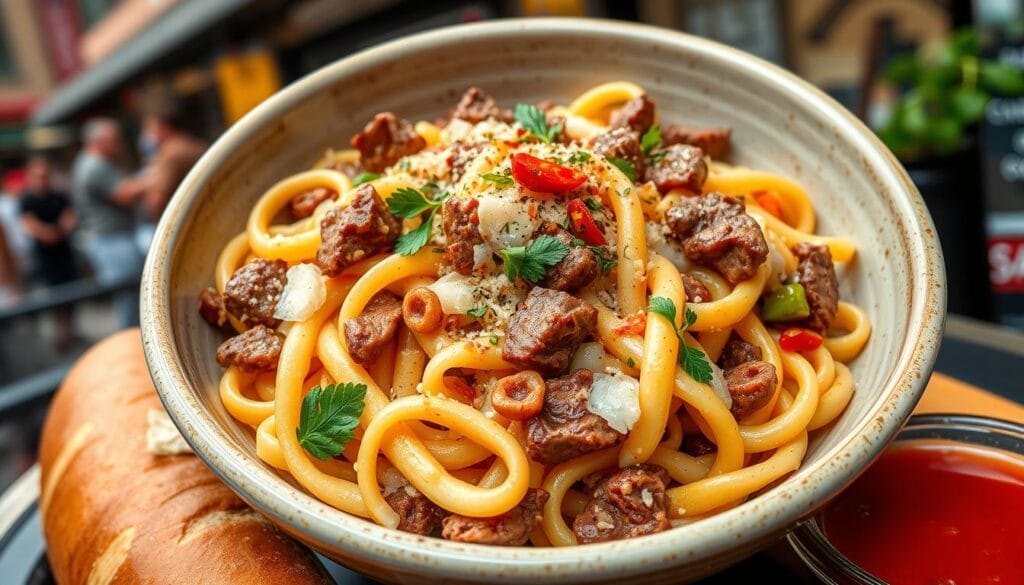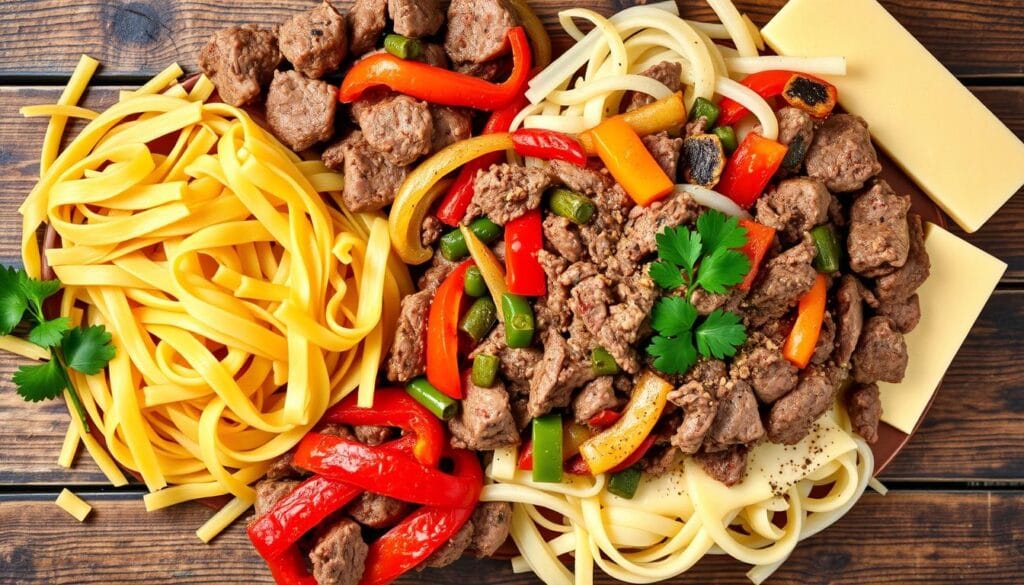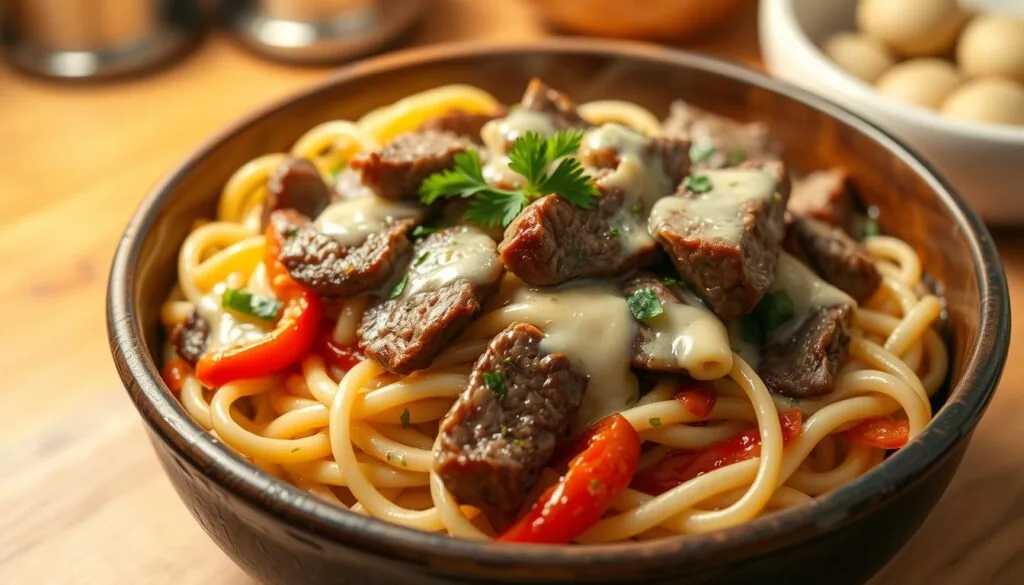Imagine turning the famous Philly cheesesteak into a tasty pasta dish. This cheesesteak pasta is a mix of street food and home cooking. It brings together Philly flavors and a warm pasta meal.
Start with ground beef, provolone cheese, and fresh veggies on top of cooked rigatoni. This Philadelphia-style pasta makes the classic sandwich into a full, satisfying dinner. It’s ready in under 45 minutes.
Table of contents
The Origins of Philadelphia-Style Pasta Fusion
The world of food has seen a big change with street food fusion, like Philadelphia-style pasta. The Philly cheesesteak, a favorite in Philly, has inspired new ways to enjoy it.

From Street Food to Pasta Bowl
The Philly cheesesteak’s story is amazing. It started in the 1930s at Pat’s King of Steaks. Now, it’s loved all over the country. Turning it into a pasta dish is a creative twist on a classic.
- Originated in Philadelphia’s bustling street food scene
- Evolved from a simple sandwich to a versatile pasta dish
- Captures the essence of traditional cheesesteak flavors
Why This Fusion Works
Street food fusion keeps the best parts of the original dish. Philly cheesesteak pasta keeps the key elements:
- Tender, thinly sliced beef
- Rich, melted cheese
- Robust seasonings
- Satisfying texture combinations
“The magic of food fusion lies in respecting the original while creating something entirely new.” – Local Philadelphia Chef
The Philadelphia Connection
Philadelphia-style pasta stays true to its roots. It uses traditional ingredients and cooking methods. Every choice, from the beef to the cheese, connects to Philly’s food history.
By making the cheesesteak into a pasta dish, chefs have made a modern twist that still respects tradition. It’s a dish that pleases both old and new tastes.
For a creative dinner idea, you might also enjoy this classic beef and tomato pasta recipe, which blends hearty beef with tangy tomato flavors.
Essential Ingredients for Perfect Cheesesteak Pasta

To make the ultimate cheesesteak pasta, you need the right ingredients. These will give your dish the real Philly taste. Start by picking top-notch ingredients that turn simple pasta into a special meal.
Now, let’s look at the main ingredients for a great cheesesteak pasta:
- Pasta Base: Penne or rigatoni are best for holding the creamy sauce
- Protein: Use thinly sliced sandwich steaks or lean ground beef
- Cheese Selection: Provolone cheese pasta needs the best provolone for flavor
- Vegetable Blend: Add fresh green peppers, onions, and mushrooms
“The secret to great cheesesteak pasta is in the quality of your ingredients.”
When making shredded beef pasta, season the meat right. Mix kosher salt, black pepper, and garlic powder. This will make your meat taste amazing.
| Ingredient | Quantity | Purpose |
|---|---|---|
| Olive Oil | 2 Tablespoons | Sautéing vegetables and meat |
| Provolone Cheese | 1 Cup | Creating rich, creamy sauce |
| Beef Broth | 2 Cups | Adding depth of flavor |
Your aim is to mix textures and flavors well. This will bring the classic Philly cheesesteak taste to your pasta.
The Art of Selecting the Right Pasta Shape for Cheesesteak Pasta
Choosing the perfect pasta shape is key to a great cheesesteak pasta dish. The right pasta captures flavors and makes your dish special.

When making a tasty pasta for cheesesteak, texture and sauce-holding are important. Rigatoni pasta is the top choice for this reason.
Why Rigatoni Reigns Supreme
Rigatoni’s tubular shape is perfect for holding cheese sauce and beef. Its ridged surface holds sauce well, making every bite flavorful.
- Large, hollow tubes
- Substantial ridged surface
- Excellent sauce-holding capabilities
- Sturdy structure that withstands heavy ingredients
Alternative Pasta Options
While rigatoni is the best, other pasta shapes can also work well in cheesesteak pasta.
| Pasta Type | Sauce Retention | Texture | Best For |
|---|---|---|---|
| Penne | Good | Firm | Lighter sauces |
| Fusilli | Excellent | Spiral | Chunky ingredients |
| Gluten-free Rotini | Moderate | Variable | Dietary restrictions |
Texture Considerations
Your pasta should match the beef and cheese sauce. Look for pasta that keeps its shape well after cooking and can handle heavy ingredients.
The secret is finding a pasta that doesn’t just hold sauce, but becomes an integral part of the dish’s flavor profile.
Try different pasta shapes to find your favorite cheesesteak pasta. The right pasta can make your dish unforgettable.
This guide to mastering cheese-based casseroles might provide extra inspiration for creamy pasta dishes.
Mastering the Cheese Sauce for Cheesesteak Pasta
Making the perfect cheese sauce for pasta is an art. It can turn your cheesesteak pasta into something truly special. Your provolone cheese sauce will be the key to a creamy, luxurious dish.
To make an amazing cheese sauce, follow these steps:
- Start with a classic roux base using butter and flour
- Slowly add milk and half-and-half
- Melt provolone cheese slowly to prevent separation
- Strive for a velvety, smooth texture
The secret to a great pasta sauce is its texture. You want it to stick to your pasta without being too heavy or greasy. Provolone cheese adds a rich, slightly sharp flavor that goes well with the beef.
“A great cheese sauce is about balance – smooth, rich, and never too thick.”
Pro tip: Use freshly grated provolone instead of pre-shredded cheese. Pre-shredded cheese often has anti-caking agents that can ruin the sauce’s smoothness.
Your aim is a cheese sauce that coats the pasta and beef perfectly. This way, every bite will have a perfect blend of flavors.
Preparing the Signature Beef Component of Cheesesteak Pasta
Making the perfect beef base is key for a delicious cheesesteak pasta dish. The right seasoning, cooking methods, and temperature control make all the difference. They turn your meal into something truly special.
Seasoning Secrets for Beef Pasta
Seasoning beef for pasta needs a careful plan. You want to add layers of flavor that match the dish. Here are some seasoning tips to get you started:
- Start with a mix of garlic powder, Italian seasoning, and Worcestershire sauce
- Add freshly ground black pepper to bring out the beef’s taste
- Use salt carefully – the broth and cheese will add saltiness too
Cooking Techniques for Cheesesteak Perfection
Learning how to cook cheesesteak is crucial. You can use ground beef or thin steak strips for the best texture. The key is controlling the heat.
| Meat Type | Cooking Time | Heat Level |
|---|---|---|
| Ground Beef | 7-10 minutes | Medium-high |
| Steak Strips | 5-7 minutes | Medium |
Temperature Control for Beef Preparation
Controlling the temperature of the beef is vital. It prevents toughness and keeps the meat juicy and flavorful. Use a 10-12 inch skillet for even heat.
“The key to perfect beef is not just seasoning, but precise heat management.”
Pro tip: Cook your beef until it’s well-browned but not overcooked. Aim for an internal temperature of 160°F for ground beef or medium doneness for steak strips.
The Perfect Vegetable Blend for Cheesesteak Pasta
Making a great vegetable blend for pasta can turn your cheesesteak pasta into something special. The right mix of sautéed vegetables can make the dish truly stand out. It brings the flavors of Philadelphia right to your kitchen.
When picking your vegetables, choose classic cheesesteak favorites. These should match well with the beef and cheese. A good mix includes:
- Green bell peppers (sliced thin)
- Sweet yellow onions
- Fresh mushrooms
- Minced garlic
To get sautéed vegetables just right, slice them evenly. This ensures they cook evenly. Cook them in the same pan as the beef. This lets them soak up all the meaty flavors.
| Vegetable | Quantity | Preparation Tip |
|---|---|---|
| Green Peppers | 1 medium | Slice into thin strips |
| Yellow Onions | 1 large | Dice uniformly |
| Mushrooms | 8 oz | Slice or quarter |
| Garlic | 3-4 cloves | Mince finely |
“The secret is to cook vegetables until they’re tender but still retain a slight crunch” – Philadelphia Chef’s Recommendation
Pro tip: Adding spinach or diced tomatoes can boost nutrition. They also add more flavor and nutrients to your cheesesteak pasta.
Step-by-Step Cooking Process
Turning your kitchen into a cooking adventure, making cheesesteak pasta is fun. This guide will help you cook pasta perfectly. You’ll get a meal that tastes like Philadelphia’s famous sandwich.
Preparation Phase
First, get all your ingredients ready. You’ll need:
- 2 cups elbow noodles
- 1 lb lean ground beef
- 1 medium yellow onion, diced
- Red and green bell peppers
- Mozzarella and provolone cheese
- Seasonings: salt, pepper, Worcestershire sauce
Cooking Sequence
Begin by cooking the pasta until it’s al dente. Pro tip: Use a lot of salt in the water for extra flavor. While the pasta cooks, cook the ground beef in a skillet. Break it into small pieces and season with Worcestershire sauce, salt, and pepper.
Then, sauté the onions and bell peppers in the same skillet. Cook them until they’re soft and slightly browned. This step adds layers of flavor to your pasta.
Assembly Instructions
The last step is to mix everything together. Drain the pasta and put it back in the pot. Add half the beef and make a cheese sauce by melting mozzarella and provolone.
“Great pasta is all about balance and technique” – Chef’s Secret
Now, top the pasta with the rest of the beef and some parsley. Your cheesesteak pasta is now ready to eat!
| Nutritional Value | Amount |
|---|---|
| Calories | 782 kcal |
| Protein | 47g |
| Carbohydrates | 52g |
Storage and Reheating Guidelines
Storing cheesesteak pasta is key to keeping its flavor and texture. After you’ve enjoyed it, you’ll want to save the taste for later. Here are the best tips for storing leftover pasta.
“Proper storage is the secret to enjoying restaurant-quality pasta at home”
Reheating pasta dishes right is important. Your cheesesteak pasta can stay fresh in the fridge for 3-4 days. Here’s how to keep it tasting great:
- Cool the pasta completely before storing
- Use a sealed container to prevent moisture loss
- Store in the refrigerator at or below 40°F
- Add a splash of milk when reheating to restore creamy texture
Choosing the right way to reheat is crucial. You have two main options:
- Stovetop Method: Gently reheat in a pan with a little milk, stirring frequently
- Microwave Method: Use medium power and stir every 30 seconds
Pro tip: Don’t freeze cheesesteak pasta. The creamy sauce and meat can separate, ruining the dish.
| Storage Detail | Recommendation |
|---|---|
| Refrigeration Time | 3-4 days |
| Recommended Reheating | Stovetop or microwave with milk |
| Freezing | Not recommended |
By sticking to these storage and reheating tips, your cheesesteak pasta will stay as tasty as the first time you made it.
Creative Variations and Adaptations
Exploring cheesesteak pasta variations opens up a world of culinary creativity. Your classic recipe can transform with simple ingredient swaps and innovative techniques. These pasta adaptations allow you to personalize the dish while maintaining its core deliciousness.
Let’s dive into some exciting creative pasta recipes that will elevate your cheesesteak pasta experience:
- Cheese Alternatives: Swap provolone for sharp cheddar or creamy mozzarella to create unique flavor profiles
- Protein Variations: Replace beef with ground turkey, chicken breast, or plant-based crumbles for dietary flexibility
- Vegetable Enhancements: Incorporate spinach, diced tomatoes, or roasted bell peppers for added nutrition
- Spice Level Adjustments: Customize heat with red pepper flakes or hot sauce to suit your taste
Check out these exciting pasta adaptations that can transform your cheesesteak pasta:
| Variation Type | Key Ingredients | Flavor Profile |
|---|---|---|
| Spicy Mexican | Jalapeños, pepper jack cheese | Bold and zesty |
| Mediterranean | Feta, oregano, olives | Herbaceous and tangy |
| Vegetarian | Portobello mushrooms, goat cheese | Rich and earthy |
“Cooking is about experimentation and making a recipe your own!” – Professional Chef
Remember, the key to great cheesesteak pasta variations is balancing flavors while respecting the dish’s Philadelphia roots. Don’t be afraid to experiment and create your signature version!
Pairing Suggestions and Serving Ideas
When you make your cheesesteak pasta, picking the right sides can make it even better. The right pairings and serving ideas can turn a tasty dish into a memorable meal.
Complementary Side Dishes
Your cheesesteak pasta needs sides that match its rich taste. Here are some great choices:
- Crispy French fries for a classic texture
- Grilled vegetable skewers adding smoky notes
- Roasted buffalo cauliflower for a spicy kick
- Tangy coleslaw to balance the richness
- Air-fried tater tots for extra crunch
Beverage Pairings
Choosing the right drink can make your pasta taste even better. Here are some drink options for your cheesesteak pasta:
| Beverage Type | Flavor Complement |
|---|---|
| Craft Beer | Robust amber ales |
| Red Wine | Medium-bodied Cabernet Sauvignon |
| Non-Alcoholic | Sparkling water with lemon |
Presentation Tips for Pasta Dishes
Make your cheesesteak pasta look amazing with these tips:
- Use large, shallow bowls to showcase ingredients
- Garnish with fresh chopped parsley
- Sprinkle additional grated cheese on top
- Serve family-style directly from a cast-iron skillet
A beautifully presented pasta dish is a feast for both eyes and palate.
These pairing suggestions and serving ideas will make your cheesesteak pasta unforgettable. It will delight all your senses.
Troubleshooting Common Challenges
Dealing with pasta cooking challenges can be tough, like making cheesesteak pasta. Success comes from mastering a few key techniques. These can turn mistakes into tasty meals.
Temperature control is key when fixing pasta dishes. Keep your sauce at a gentle simmer to avoid breaking. This ensures a smooth, creamy texture, just like a perfect cheesesteak pasta.
- Sauce Separation Prevention: Stir occasionally and maintain low heat
- Pasta Texture Management: Cook pasta al dente to avoid mushiness
- Consistency Control: Add pasta water or milk if sauce becomes too thick
For great cheesesteak pasta, focus on quality ingredients and cooking times. Chefs say using a food thermometer is key. It helps your steak cook perfectly without overcooking.
“Cooking is about confidence and understanding your ingredients’ behavior.” – Culinary Expert
Quick fixes for common issues:
- Bland flavor? Adjust seasonings gradually
- Sauce too thick? Thin with warm pasta water
- Meat too tough? Slice against the grain and cook briefly
Remember, practice makes perfect. Every time you make cheesesteak pasta, you’ll get better. You’ll understand this tasty dish more.
Conclusion
Your cheesesteak pasta recipe is a tasty mix of comfort and tradition. It turns classic Philly dishes into a dish you can make at home. With tender steak, sautéed bell peppers, and creamy provolone sauce, it’s a perfect blend.
This recipe lets you add your own twist. You can pick ground beef or steak, and choose pasta like rigatoni or penne. It’s healthy, with 650-700 calories per serving, and full of protein and carbs.
It’s great for family dinners or when you have guests over. The Philly cheesesteak pasta brings restaurant flavors right to your table. You can sear steak in 4-5 minutes and make a golden cheese topping.
Great cooking is about passion, creativity, and enjoying the journey. Your cheesesteak pasta is a celebration of food innovation. It honors Philly’s food heritage and creates new memories in your kitchen.
FAQ
What makes cheesesteak pasta different from a traditional Philly cheesesteak?
Cheesesteak pasta turns the classic sandwich into a comforting dish. It combines beef, peppers, and onions with rigatoni and creamy provolone cheese sauce. This way, it keeps the original taste but offers a more versatile meal.
Can I make cheesesteak pasta with a different type of meat?
Yes! You can use ground turkey, chicken breast, or plant-based meat instead of beef. Just remember to keep the seasoning and cooking method the same to get that authentic cheesesteak flavor.
What is the best cheese to use for cheesesteak pasta?
Provolone cheese is the top choice for a true Philly cheesesteak taste. But, you can also try mozzarella, cheddar, or a mix of cheeses to find your favorite.
How long can I store cheesesteak pasta?
Store it in an airtight container in the fridge for up to three days. For longer, freeze it for a month. When reheating, add a bit of milk to keep the sauce creamy.
What pasta shape works best for cheesesteak pasta?
Rigatoni is the best because it holds sauce well. But, you can also use penne, fusilli, or gluten-free options based on your needs and likes.
Can I make this dish vegetarian?
Yes, use plant-based meat, add spinach or mushrooms, and keep the creamy cheese sauce. The goal is to keep the dish’s flavor and texture.
What side dishes pair well with cheesesteak pasta?
Try mixed green salads, roasted veggies, or garlic bread. For drinks, red wines or craft beers that match the dish’s rich flavors are great.
How can I prevent the cheese sauce from separating?
Keep the heat low and stir often. Make the sauce by first making a roux, then adding milk and cream slowly. If it thickens too much, add a bit of milk or pasta water.
What’s the secret to getting the most flavor in cheesesteak pasta?
Brown the beef well, sauté the veggies in the same pan, and use quality provolone cheese. Seasoning the beef with salt, pepper, and steak seasoning also helps.

